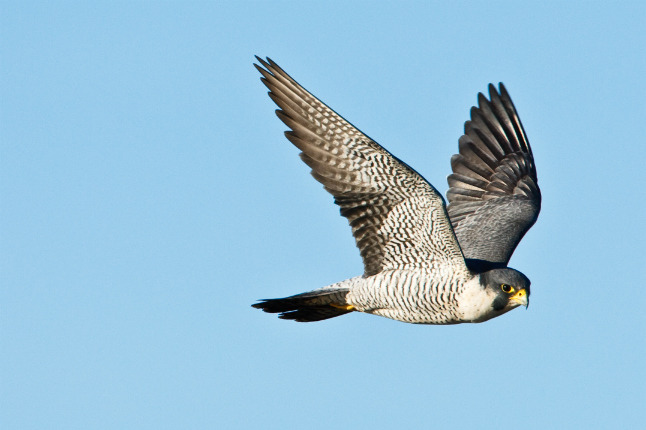Learning To Fly: A New Generation Takes Wing
People who study peregrine falcons wake up early. It's hard to roll out of the sack at 4am, well before the summer sun comes up, but over the years I've done so gladly, privileged to join several early-bird researchers in western Colorado's Black Canyon National Park.
In July, the eggs have long since hatched and the young are getting ready to fledge—to take flight and begin a new life out of the nest. Peregrine falcons maintain a seasonal home territory in which they establish an eyrie, or nesting site, and their spring migration brings them back to it year after year. Shortly after a pair migrates north in the spring, the birds scratch out a depression into the shallow soil of a cliff shelf, and the female lays her eggs.
The chicks, usually up to four, all hatch within 48 hours of each other. Perhaps because all are born within a short time span, none becomes especially dominant, and sibling rivalry is limited. Nobody gets pushed off the cliff in a fit of jealousy.
They eat voraciously. As summer advances, they get hungrier every day, and it becomes important for the adults to succeed at catching the plump larger birds, such as rock doves. The hunger of older chicks, much like that of starving teenagers who suck the contents out of a refrigerator, seems to be bottomless.
Fledging, that moment when the young finally take wing, happens in mid- or late July. The consternation felt at the eyrie might be similar to that felt by human parents when they first sit in the passenger seat of a car and let their teenager get behind the wheel. The young birds have watched many times as a parent takes off effortlessly from the ledge to fly into the unknown. And children have watched drivers many times before they put the key into the ignition themselves. In both cases, the young are more than ready to take off on their own.
Imagine the scene for the falcons, squeezed onto a tiny ledge. The precipice descends thousands of feet. They have never known flight. The male and female model correct behavior, standing erect and flapping their wings to demonstrate the process. A lot of squawking and screeching is involved. The adults let out a shriek, the fledgling cries back. The young falcon, its juvenile feathers all grown in, steps to the edge, where the slightest mistake could mean disaster and heartbreak, and (the parents watching and holding their breath) it flaps its wings and takes flight. It makes a ride around town with a new driver seem almost relaxing in comparison.
The parents continue to protect their fledglings until they can hunt for themselves. It takes about a month and a half for the young ones to learn to fly acrobatically—power-diving at over 200 mph, rolling, soaring and, ultimately, hunting for and catching their own meals. Once, when I was with a couple of colleagues looking into a particularly steep part of Black Canyon, we disturbed a fledgling near the edge. Its cries signaled the parents, and they zeroed in on us like a pair of F-15 fighter planes. Their dive-bombing hastened our quick retreat. We learned then that fledging doesn't end once the young have made their first flight.
Could it also be true for humans? The leap off the precipice seems something like high school graduation. But that doesn't ensure success or complete independence. Witness parents who drop off a young one headed for boot camp and a career in the military, or watch parents walk away from a college dormitory where their fledgling is a freshman. Like the peregrines, parents are there to guide, cajole, squawk and screech all along the way, only now from a distance.
Peregrine adults devote enormous energy to guaranteeing that their young have all they need for a successful flight and a successful life. The adults and juveniles will spend the rest of the summer hunting, nurturing, socializing. The adults pass on all they know. The young learn how to be peregrines.
Next year, the adult pair will be back to lay a new clutch of eggs, raise new chicks and undergo yet more screeching and crying. Their young may well be starting new families nearby, in Unaweep Canyon or Dominguez-Escalante National Conservation Area—places that never used to host peregrines. Sitting next to a cliff at Black Canyon in the earliest hours of daylight, in the stillness of the dawn, researchers can see the turning of time. They feel the sense of the cycle of life from one generation to the next.
–
This essay first appeared in High Country News.
